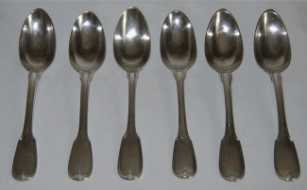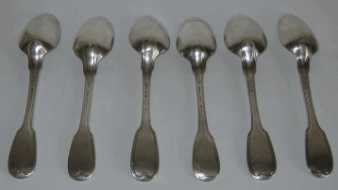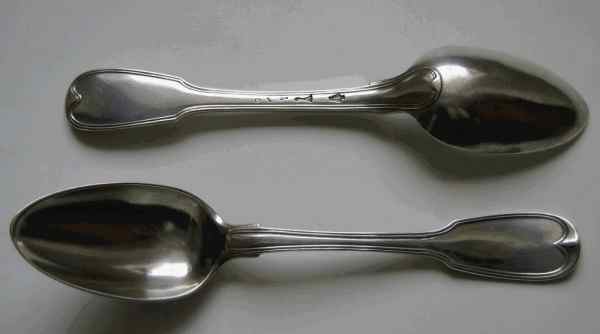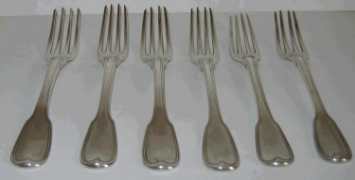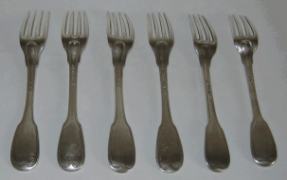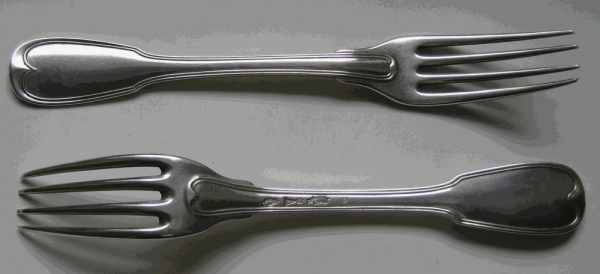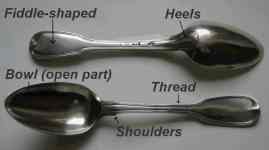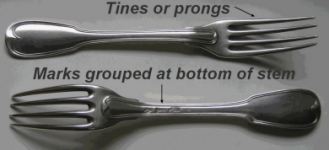by Giovanni
Ciceri
(click on photos to enlarge image)
A FRENCH CANTEEN (Part)
- Paris 1764/1819 -
In this article we present a part of a French canteen composed
of pieces of various age and makers. Most pieces were
manufactured and hallmarked in Paris between 1762 and 1819. The
prevalent pattern is the so called fiddle thread, very popular
in France from the mid 18th century.
Set of six fiddle pattern table spoons - Paris 1772 –
1809
This set of table spoons is composed of pieces of various
age and makers. All pieces were manufactured and hallmarked in
Paris between 1766 and 1809.
The pattern is the so called fiddle thread, very popular in
France from the mid XVIII century. Fiddle pattern derives its
name from the fiddle-shaped handle and must rate as one of the
major design of flatware.
Although a similar pattern is present in examples from the
Esquiline Treasure of the late Roman period (British Museum), it
originated in France, where it was the most popular pattern in
the mid-eighteen century. The pattern is a very typical French
style double struck Fiddle Thread, with spoons turning up
(note 1) and
soft shoulders (note 2). English examples usually date from the beginning of
the 19th century (apart from some very rare pieces dating earlier)
and turn down (note 3).
The spoons have thread heels (note 5).
All spoons are bottom marked (marks grouped at bottom of
stem) and were fully hand made with good gauge of silver.
Dimension: 21 cm in length; weight: 524 g (combined)
Hallmarks on the Spoons
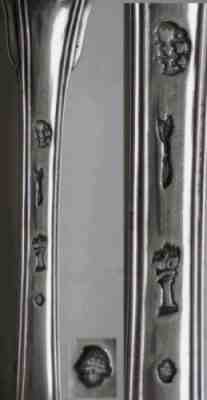 |
(from top to bottom)
Silversmith mark: NML for Nicolas Martin LANGLOIS,
registered in 1757 in Paris, LANGLOIS changed his
mark in 1766 with two fleurs de lys (as in our
picture). Before, the mark had two large dots
instead of fleurs de lys,
Crowned A: Paris 1768-1774, for "charging" the item
before paying tax. Unfortunately, the Charge mark is
very much spun off.
Crowned I: warranty, Paris 1772-1773,
Small head with helmet: Paris 1768-1774, certifying
that tax was paid ("Discharge")
|
 |

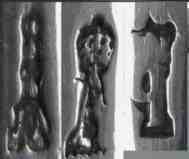 (from left to right)
(from left to right)
Monkey Head: Discharge mark, Paris 1774-1780.
Silversmith mark: Jacques ANTHIAUME, registered 1758, Paris,
Crowned A: Charge mark, Paris 1774-1780,
Crowned Q: Warranty mark, Paris 1779-1780,
|
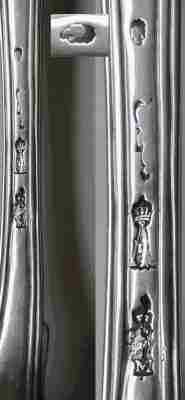 |
(from top to bottom)
Parrot’s head: discharge mark (tax paid) for Paris
1786-1789,
Large crowned P: Paris 1787-1788, unfortunately much
erased,
Large crowned A: Paris 1782-1789 used for "charging"
the item before paying tax,
Silversmith mark: too much broken to be attributed.
Unreadable mark. Potentially it may belong to at
least three different masters.
|
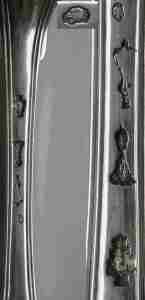 |
(from top to bottom)
Parrot’s head: Discharge mark (tax paid) for Paris
1786-1789,
Large crowned P: Paris 1787-1788 (warranty),
unfortunately very much erased,
Large crowned A: Paris 1782-1789 used for "charging"
the item before paying tax,
Silversmith mark: Pierre Nicolas SOMMÉ (PNS)
registered in 1760. Known activity up to 1809. SOMMÉ
changed his mark in 1768 adopting the mark pictured
aside
|
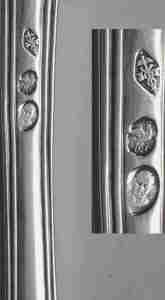 |
(from top to bottom)
Silversmith mark: Jean TOULON, registered in 1798,
Paris. JT with Mercury's wand,
Cock with 1 on the right: Paris 1798-1809, first
silver content (950/1000),
Head of an ancient man (tete de veillard): Warranty
mark, Paris 1798-1809, The digits 8 and 5 aside left
and right of the head identify Paris.
|
Set of six fiddle pattern table or dessert forks - Paris
1764 - 1809
This set of table forks is composed of pieces of various age
and makers. All pieces were manufactured and hallmarked in Paris
between 1766 and 1809.
The pattern (Fiddle Thread) is the same as described for the spoons.
As for the spoons, the forks turn up
(note 4). On
the contrary of spoons, this is common also on English flatware.
At this time most of the forks had four tines (instead of three
tines of the earlier examples).
Forks have thread heels
(note 5).
All forks are bottom marked (marks grouped at bottom of stem)
and were fully hand made with good gauge of silver. In some
cases tines are of different length. This is caused by the rough
use of knives which wears the tines. Dimension: 20.2 cm in
length; weight: 554 g (combined)
Hallmarks on Forks
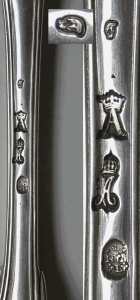 |
(from top to bottom)
Discharge Mark (tax paid): dog’s head (a pointer),
used in Paris 1762-1768,
First crowned A: warranty, Paris 1764-1765,
Second crowned A: Charge Mark (item declared before
paying tax), used in Paris 1762-1768,
Silversmith mark : NML for Nicolas Martin LANGLOIS,
registered in 1757 in Paris, LANGLOIS changed his
mark in 1766 with two fleurs de lys (as in our
picture). Before, the mark had two large dots
instead of fleurs de lys.
|
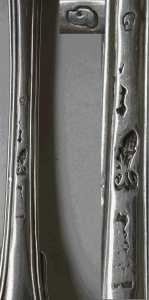 |
(from top to bottom)
Dog’s Head (a pointer): discharge Mark (tax paid)
used in Paris 1762-1768,
Second mark: unreadable. Corresponding to Warranty
Mark.
Crowned A: Charge Mark (item declared before paying
tax), used in Paris 1762-1768.
Silversmith: Jacques ANTHIAUME, JA under a shell and
the crowned fleur de lys. Registered in 1758 in
Paris, active until 1784.
|
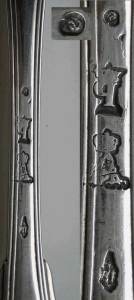 |
(from top to bottom)
Monkey Head: discharge Mark (tax paid) used in Paris
1774-1780,
Crowned Q: warranty Mark for Paris 1779-1780,
Crowned A: charge mark (item declared before paying
tax) used in Paris 1774-1780,
Silversmith mark: too much scrapped to be attributed
to any master
|
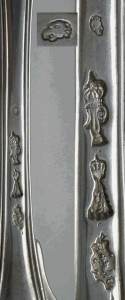 |
(from top to bottom)
Parrot’s head: Discharge mark (tax paid) for Paris
1786-1789,
Large crowned P: Warranty mark used in Paris
1786-1787,
Crowned A: Charge mark (tax declaration) used in
Paris 1782-1789,
Silversmith mark: Pierre Nicolas SOMMÉ (PNS)
registered in 1760. Known activity up to 1809. SOMMÉ
changed his mark in 1768 adopting the mark
illustrated ib the left.
|
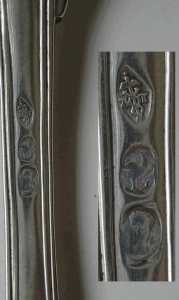
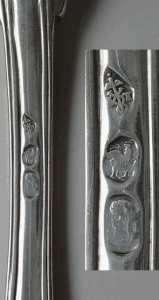 |
(from top to bottom)
Silversmith mark: Jean TOULON, registered in 1798,
Paris. JT with Mercury’s wand,
Cock with 1 on the right: Paris 1798-1809, first
silver content (950/1000),
Head of an ancient man (tete de veillard): Warranty
mark, Paris 1798-1809, The digits 8 and 5 aside left
and right of the head identify Paris.
|
Basting spoon: 1809 - 1819
This very rare basting spoon is made in a revival of the
"Dog Nose" pattern (in this case with thread), very popular at
the end of the 17th century. These particular and large size spoons
were used for serving solid and semi-solid food from tureens and
covered vegetable servers.
Note that the spoon turns up (the handle is curved towards the
open part of the bowl), as usual for items manufactured in
France. In England this rule did not apply after the third quarter
of the 18th century. From this date on spoons usually turn down.
The part where the bowl is attached to stem was usually
reinforced on the back with a "drop" of silver, but in this case
the back is completely plain.
The spoon is bottom marked (marks grouped at bottom of stem)
for French province 1809-1819 and second silver standard
(800/1000). At this time flatware were completely hand made with
good gauge of silver. Dimension: 25.8 cm in length; weight: 130
g
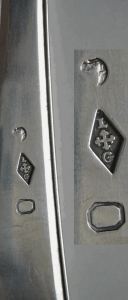 |
(from top to bottom)
Warrior's head with helmet: warranty mark, French
province 1809-1819. Normally, the helmet should have
two digits (erased here) for recognizing the town
where the spoon was marked
Silversmith mark (LG): not found.
Mark fully erased: it should be a cock with number 2
on bottom-left corner, for French province
1809-1819, second silver content (800/1000).
|
ENDNOTES
- note 1: a spoon turns up when the handle is curved
towards the open part of the bowl
- note 2: shoulders are the "step" where the bowl closes
to the stem
- note 3: a spoon turns down when the handle is curved
towards the close part of the bowl
- note 4: a fork turns up when the handle is curved like
the tines
- note 5: heels are the part of the fork or spoon touching the
table when it lies with the tines or the bowl up
Giovanni Ciceri
- 2009 -
The author is in debt to Christophe Ginter for his
assistance in identifying most of the marks illustrated
in this article
|
|
|
 ASSOCIATION OF SMALL COLLECTORS OF ANTIQUE SILVER
ASSOCIATION OF SMALL COLLECTORS OF ANTIQUE SILVER